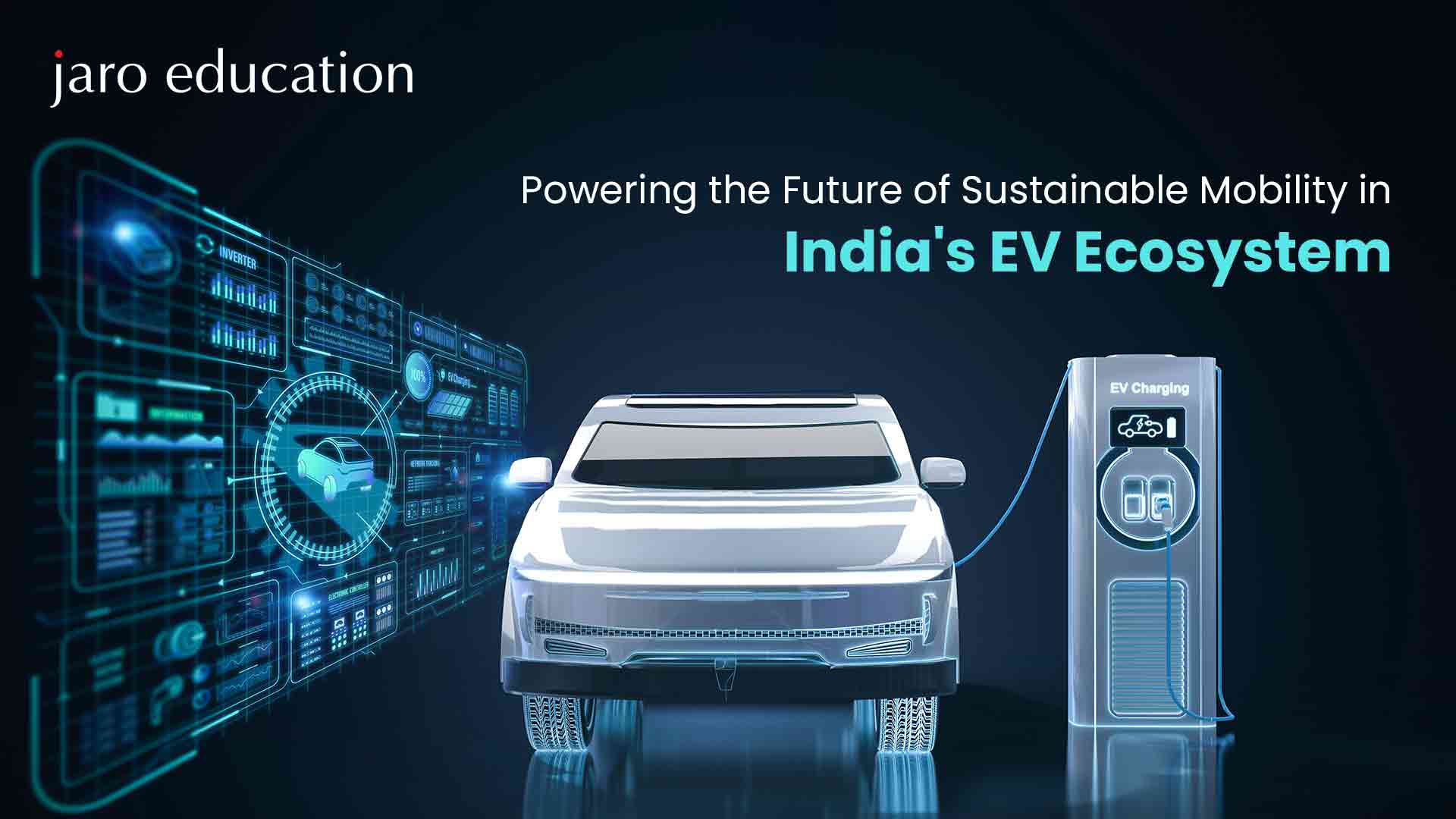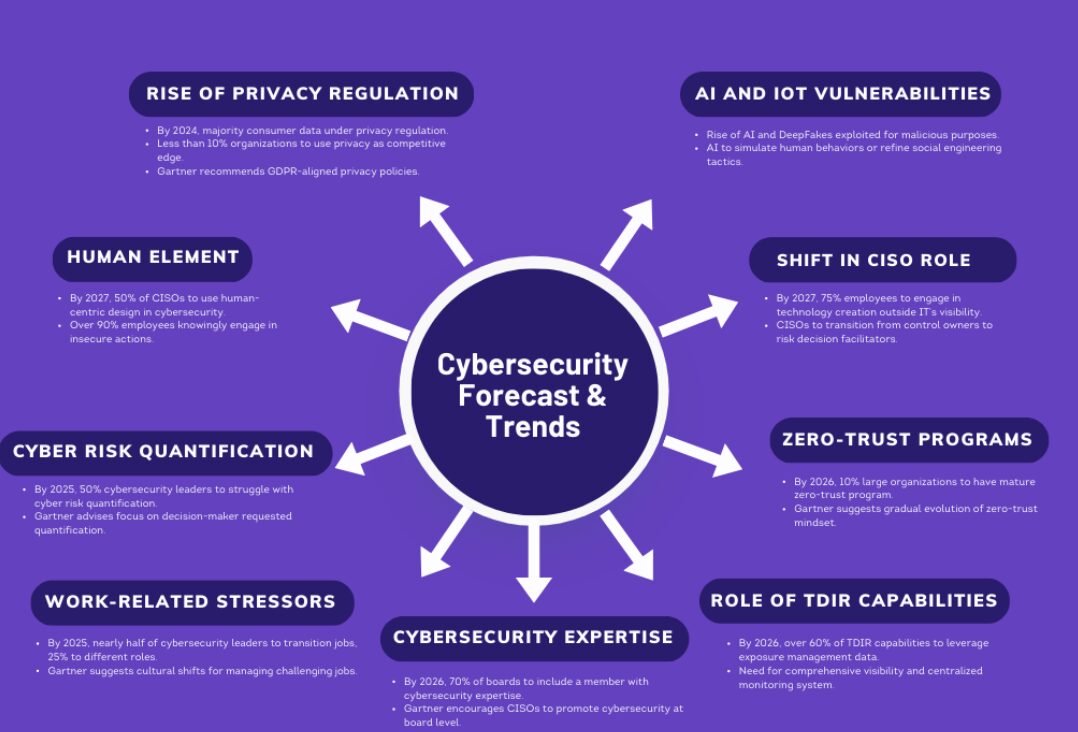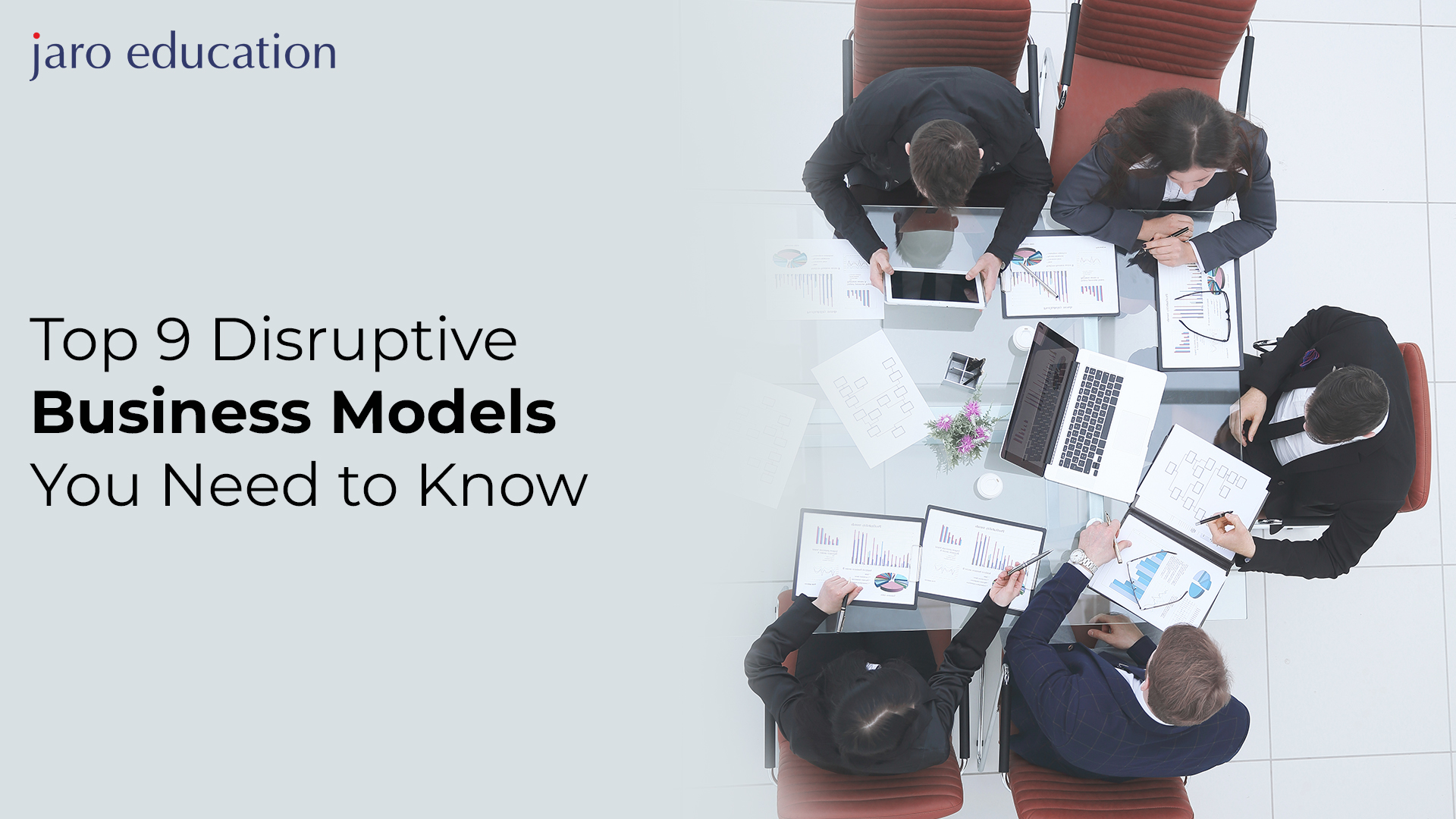
- jaro education
- 15, January 2024
- 9:00 am
In recent times, electric vehicles (EVs) have become more than a luxury – they are now a crucial response to environmental concerns. As people increasingly choose EVs for transportation, the industry is booming, projected to grow at 18.2% CAGR from 2021 to 2030, reaching $823.75 billion (Allied Market Research).
EVs are reshaping mobility by reducing emissions, promising a cleaner future. Despite their numerous benefits, significant challenges persist on the path to a sustainable transportation revolution. This blog explores the rapid growth of EVs, their environmental impact, and the hurdles in their widespread adoption.

Table of Contents
*deccanherald.com
Current Landscape of India's EV Ecosystem
With a massive population exceeding 1.4 billion, India currently relies on imports for around 84% of its crude oil requirements, solidifying its position as the world’s third-largest consumer and oil importer. The surge in global oil prices, coupled with a rise in imports and a dip in domestic oil production, has led to a noticeable uptick in India’s crude oil import bills.
As part of its commitment at COP21, India has pledged to slash its carbon footprint by 33-35% by 2030. Fulfilling this ambitious target requires a substantial shift in the country’s power generation, emphasizing a transition from fossil fuel-based transportation to renewable energy sources.
India stands as one of the leading global markets for two and three-wheeled vehicles, securing a spot among the top five nations for both private cars and commercial vehicles.
According to Vahan data, the total sales until March 31, 2023, reached 1,171,944 units. This marks the first time in a financial year that sales have crossed the one million mark. In the year 2022, electric vehicle (EV) sales in India totaled 1,023,735 units.
The 1,171,944 units sold in the fiscal year 2023 represent a significant 155% increase compared to the 458,746 units sold in the fiscal year 2022. This shows a strong rise in consumer demand for EVs, driven by high prices of petrol and diesel, as well as compressed natural gas (CNG).
The anticipated growth is on the horizon, fueled by the concerted efforts of central and state governments, along with active participation from private sector entities. The collective aim is to enhance the prevalence of electric vehicles on Indian roads significantly.
As per the latest report, India plans to make a big shift to electric vehicles (EVs) by 2030. The EV market is expected to be worth $206 billion, but we need over $180 billion for making EVs and charging stations. This change involves many people, like tech companies, car makers, customers, and government bodies at different levels.
Cities in India are especially important for the success of this plan. They play a crucial role in achieving the country’s environmental goals. In fact, in 2023, only 5% of all vehicles sold in India were electric. This included 0.7 million electric two-wheelers. So, there’s a lot of work to upon to make this shift to EVs successful.
Key players in the EV Sector in India
Electric Vehicle Manufacturer
India’s transition to sustainable mobility is being steered by influential automotive leaders, including renowned manufacturers like Tata Motors, Mahindra Electric, Kia, and Hero Electric. These industry giants are not merely producing electric vehicles (EVs) but are shaping the narrative around EVs, seamlessly blending sustainable technology with familiar automotive designs to cater to diverse market segments. Their role extends beyond manufacturing; they influence consumer perceptions of EVs.
Charging infrastructure builders
A critical element in the widespread adoption of EVs is the development of a robust charging infrastructure. Companies like Delta Electronics and ABB are at the forefront of this effort, providing cutting-edge charging solutions and innovative software platforms. By efficiently managing charging networks, these industry leaders address a key concern associated with EV adoption: range anxiety.
Battery and technology
At the core of any successful EV ecosystem lies advanced battery technology. Enterprises like Exide Industries and Amara Raja are at the forefront of battery innovation, pushing the boundaries of energy density and longevity. Additionally, EV software solutions integrated into battery management systems optimize performance, lifespan, and safety.
Digital Integration and Connectivity
As EVs evolve into digitally connected vehicles, software companies play a pivotal role. Entities like Numocity, Driivz, and ChargePoint are instrumental in developing software platforms that enable connectivity and data analytics for EVs. These platforms facilitate remote monitoring, over-the-air updates, and predictive maintenance, enhancing the overall user experience.
Academic Innovations
Research institutions and universities play a crucial role in driving innovation in software and technology. Their contributions span from battery research to developing algorithms for optimized energy management in EVs, influencing the technological landscape of the electric mobility sector.
Consumer Awareness
Non-governmental organizations (NGOs) and consumer advocacy groups are actively contributing to the EV movement by raising awareness about the myriad benefits of EVs. They play a vital role in educating the public about technological advancements and environmental advantages, fostering a positive environment for the adoption of electric vehicles.
Government’s Policies and Initiative to Boost EV Ecosystem
To achieve these ambitious goals, the Indian government has implemented initiatives such as the FAME II, PLI, and others. Here are some details about these policies and initiatives:
FAME II Initiative
Introduced in 2019 with a financial allocation of Rs 10,000 crore, the FAME II program sought to endorse the adoption of electric vehicles across various segments. Its targets encompass supporting 500,000 e-three-wheelers, 7,000 e-buses, 55,000 e-passenger vehicles, and a million e-two-wheelers. Initially set to conclude in 2022, this initiative played a pivotal role in promoting the electric vehicle ecosystem in India.
Production Linked Incentive (PLI) Scheme
In September 2021, the government rolled out the Production Linked Incentive (PLI) Scheme, earmarking a substantial budget of INR 25,938 crore (equivalent to $3.1 billion). The primary objective of this scheme is to invigorate domestic manufacturing, specifically in the realm of advanced automotive technology (AAT) products. The scheme aims to foster innovation and self-reliance in the manufacturing sector, contributing to the overall growth of the electric vehicle industry.
Electric Vehicle Charging Infrastructure
The government has issued comprehensive guidelines for establishing electric vehicle (EV) charging stations, strategically addressing various locations and vehicle types. The stipulations include the provision of charging stations every 3 kilometres in cities, 100 kilometres on roads catering to heavy-duty vehicles, and 25 kilometres on highways. Additionally, there is an emphasis on the integration of private charging stations in residential areas and office complexes. These guidelines are pivotal in building a robust charging infrastructure to support the expanding electric vehicle fleet in the country.
EV30@30
The EV30@30 Campaign, part of the Clean Energy Ministerial initiative, aims for a 30% market share for electric vehicles (EVs) by 2030. It focuses on supporting the growth of EVs in various categories, along with developing essential charging infrastructure. India’s commitment to the campaign aligns with its climate goals, targeting nearly 70% of commercial cars, 30% of private cars, 40% of buses, and 80% of two-wheelers and three-wheelers to be electric by 2030. This reflects India’s dedication to sustainable mobility and fulfilling climate commitments.
These strategic steps have attracted private entities to venture into the electric vehicle market, laying the groundwork for increased electric vehicle adoption in India. The success of India in this endeavor is poised to yield substantial positive effects not only domestically but also on a global scale.
Achievable Economical Advancements with EV
India’s complete electrification promises many advantages for businesses, investors, and consumers. Here, we delve into some of the most compelling opportunities that await various stakeholders:
Fleet Operators’ Cost Savings
Shifting to electric vehicles (EVs) presents a significant cost-cutting opportunity for fleet operators such as Amazon, DoorDash, and BigBasket. The Total Cost of Ownership (TCO) for a two-wheeler in New Delhi, as reported by Weforum.org, drops from Rs 2/km on petrol to a mere Rs 0.52/km on EVs. Despite the slower pace of EV adoption compared to other countries, government tax incentives and the proactive approach of pioneering companies in offering reliable charging solutions are addressing concerns related to high upfront costs and trust in new technology.
Opportunities for OEMs
Original Equipment Manufacturers (OEMs) stand to gain significantly from the burgeoning EV industry, with the potential to produce cost-competitive auto products in India and globally. Research suggests a 5.7% higher value addition to every EV by 2030. The Indian government’s push for supply chain indigenization under the Atma Nirbhar plan fosters an environment conducive to developing the EV ecosystem. Collaborative efforts from Indian companies are also facilitating the creation of charging apps and other features to expedite the shift to EVs.
Real Estate Sector Growth
The electric vehicle industry presents many opportunities for real estate investors, realtors, and developers. With the need for EV manufacturing units, industrial zones, and charging stations, there’s a burgeoning demand for associated infrastructure. The construction of retail spaces around EV charging stations, considering the 15 to 20-minute average charging time, is becoming a key focus. Colliers’ report underscores the substantial land requirements for battery manufacturing and charging stations, indicating ample opportunities for players in the real estate sector.
Consumer Adoption and Infrastructure Development
India’s dynamic and tech-savvy population, experiencing upward mobility, is increasingly inclined toward embracing new technologies, including electric vehicles. As individuals become more affluent, their ability to purchase EVs grows. The government and key players in India’s EV space are actively expanding charging networks and providing software solutions for convenient daily charging to meet the rising demand.
Collaborations with businesses and government agencies are resulting in innovative solutions, tapping into India’s skilled talent pool. Nitin Gadkari’s projection of five crore new jobs in the EV industry highlights the substantial employment opportunities for India’s young workforce. The new infrastructure of EV development increased the high demand for talent and special skill holders. To meet that demand, IIT Delhi introduced the Advanced Program in Electric Vehicle (EV) Technology. This initiative aims to offer a thorough grasp of Electric Vehicle (EV) technology, catering to recent graduates and professionals across various industries. The goal is to assist them in developing the essential skills, capabilities, and knowledge necessary for the field of e-mobility.
EV Ecosystem challenges for India
Indian urban centers play a crucial role in fulfilling their nationally determined contributions (NDCs). As discussed above in 2023, electric vehicles (EVs) constituted less than 5.5% of overall vehicle sales in India. This low adoption rate can be attributed to various challenges encountered by Indian cities as they navigate the transition to e-mobility, as outlined below:
Charging Infrastructure Evolution
Back in 2016, India boasted fewer than 500 EV charging stations spread across major cities like Delhi, Mumbai, Bengaluru, and Kolkata. Fast forward to July 2020, and the count had risen to 993. Looking ahead to 2030, the projection is staggering – Delhi alone is anticipated to necessitate about 300,000 high-speed charging stations. Achieving this demand is contingent on a 30% penetration of EVs among a car population of around 10 million, requiring an investment in the ballpark of US $1.5 billion. Strategic placement of these stations is paramount, and the implementation of high-speed chargers mandates considerable investments, coupled with an essential expansion of power grids to prevent any operational hiccups.
E-Waste Management Challenges
Effectively handling, disposing of, and overseeing EV batteries as they reach the end of their life cycle will necessitate substantial growth in the recycling industry. Presently, a significant portion of e-waste finds its way into landfills, a hazardous and unsustainable method of dealing with such refuse. Urgent policy changes are imperative to encompass EV batteries within the ambit of regulated waste management, lest our cities risk transforming into dumping grounds for the burgeoning volume of EV waste.
Initial Cost Barrier
A major obstacle to the widespread adoption of electric vehicles is the higher upfront cost than traditional vehicles, primarily due to the expensive batteries. This pricing gap has made electric vehicles less affordable, especially in price-sensitive markets like India. The recent introduction of sub-lakh electric cars by Tata and MG in 2023 is a positive step, potentially encouraging other manufacturers to make electric vehicles more budget-friendly.
Charging Time Challenge
Charging an electric vehicle (EV) can take up to 8 hours with a slow charger, depending on battery size. This, coupled with comparisons to quick refueling at petrol stations, hampers EV adoption. Despite ongoing efforts to reduce charging times, widespread deployment faces obstacles due to substantial capital requirements. Coordinated government policies at both Central and State levels are crucial to overcoming these challenges and accelerating EV integration across India.
Standardization Challenges
The absence of standardized protocols and interoperability among charging networks hinders EV adoption. The government, along with industry stakeholders and auto OEMs, must prioritize creating uniform standards and promoting fast-charging technologies. While steps have been taken, gaps still exist, impeding the progress required to meet 2030 adoption goals.
Safety Concerns
Addressing safety issues is crucial for building consumer trust in EVs. Risks related to battery technology, such as thermal runaways and fires, must be tackled. The government should implement stringent safety standards for EVs, charging infrastructure, and battery manufacturing, collaborating with international organizations to develop comprehensive guidelines and best practices. This proactive approach ensures a secure environment for widespread electric vehicle acceptance.
In Summary: India’s EV Ecosystem is a Global Win
More electric cars were sold worldwide in 2022, going up by about 60%. It’s the first time more than 10 million electric cars were sold, even though overall car sales weren’t great last year. Now, one out of every seven cars sold is electric. Plus, as per a recent report by Statista, it is predicted that the number of electric cars sold will go up to 17.07 million by 2028. While this target may seem modest at first glance, a 30% adoption rate carries substantial environmental and economic global implications.
India ranked as the third-largest global oil importer, is poised to undergo a transformative shift with its embrace of EVs, significantly diminishing its reliance on oil and causing disruptions in the global oil markets. Achieving these ambitious adoption targets could position India as a model for other emerging economies looking to replicate similar successes, consequently contributing to a reduction in global dependence on fossil fuels.
Furthermore, given India’s vast population of 1.4 billion and its rapidly expanding economy, the nation is undeniably set to play a pivotal role in the contemporary global EV market. A complete transition to electric vehicles within India would not only mark a substantial stride towards sustainable development in global mobility but also have far-reaching effects on oil markets as reliance on this finite resource diminishes. The potential impact of India’s commitment to EV adoption extends beyond its borders, influencing and inspiring advancements in sustainable mobility on a worldwide scale.








